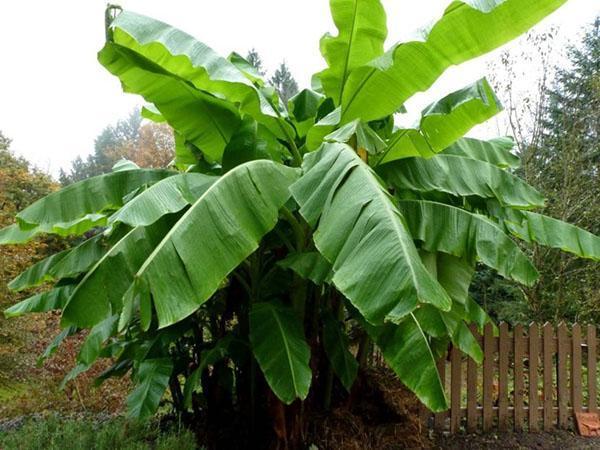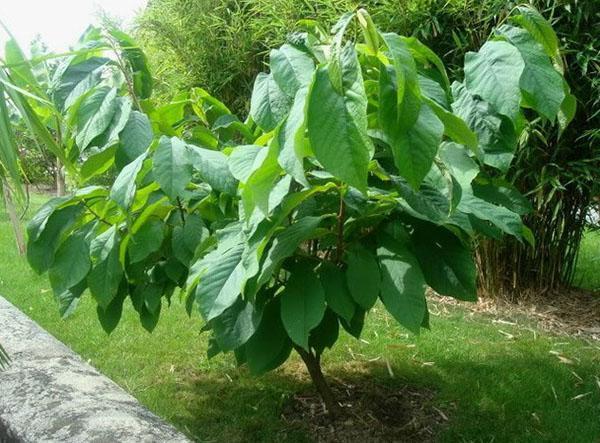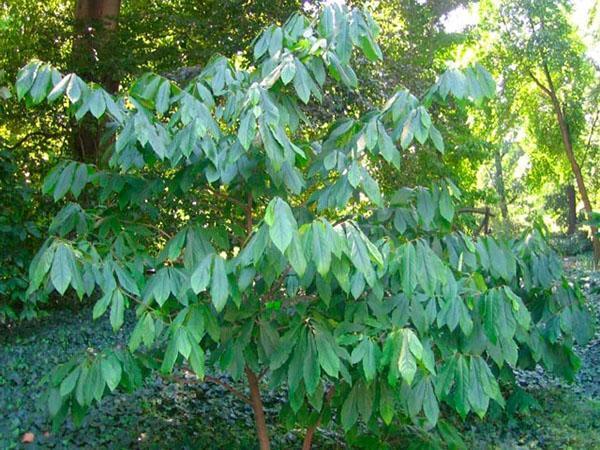Delicious exotic at their summer cottage - banana tree
 When tropical fruits appear on store shelves, residents of European countries want to feast on them. It turns out that some of them, for example, a banana tree, can be grown in your summer cottage and in the form of a houseplant. It is enough to learn the secrets of growing such plants, put them into practice and work tirelessly. The most persistent gardener will be rewarded with a bountiful exotic harvest in his own garden. What is the secret of growing a banana tree in the middle latitudes of Europe? Everything is much simpler than many indecisive gardeners think.
When tropical fruits appear on store shelves, residents of European countries want to feast on them. It turns out that some of them, for example, a banana tree, can be grown in your summer cottage and in the form of a houseplant. It is enough to learn the secrets of growing such plants, put them into practice and work tirelessly. The most persistent gardener will be rewarded with a bountiful exotic harvest in his own garden. What is the secret of growing a banana tree in the middle latitudes of Europe? Everything is much simpler than many indecisive gardeners think.
A pleasant acquaintance with a plant from the tropics

This thermophilic plant was first seen in North America, but over time has spread throughout the earth. It easily migrated to Europe, it is known in Asia, Africa and Japan. The plant is grown not only in suburban areas, but also in closed living quarters.
Despite its origin, this unique tree is able to withstand frosts down to -30 ° C without ceasing to bear fruit.
Basically, it prefers moist soil, therefore it is found near large bodies of water. The plant got its name due to the fact that its fruits resemble everyone's favorite banana, exotic mango or pineapple.
Under natural conditions, it can grow up to 9 m in height. It has a wide crown in the form of a pyramid, on which oblong glossy ovoid leaves grow. During the flowering period, bell-shaped buds of a purple hue appear on the tree.  They are like bright lights against the background of lush greenery, which attract all kinds of insects. It is for these excellent inflorescences that the banana tree is grown at home, as an ornamental plant.
They are like bright lights against the background of lush greenery, which attract all kinds of insects. It is for these excellent inflorescences that the banana tree is grown at home, as an ornamental plant.
 The fruit is usually oblong in shape. They are painted green, which turns yellow when ripe. Under the thin skin is a delicate whitish pulp, rich in sucrose and fructose. This makes the fruit taste very sweet. In addition, it exudes a pineapple-like scent.
The fruit is usually oblong in shape. They are painted green, which turns yellow when ripe. Under the thin skin is a delicate whitish pulp, rich in sucrose and fructose. This makes the fruit taste very sweet. In addition, it exudes a pineapple-like scent.
 The juicy pulp of the banana tree contains a huge amount of trace elements necessary to strengthen the body's defenses. Fruits grow in small stems of 9 pieces each, which looks very appetizing. Who doesn't want to grow such a miracle on their site or in the indoor garden? Only lazy people who are indifferent to greenery will refuse.
The juicy pulp of the banana tree contains a huge amount of trace elements necessary to strengthen the body's defenses. Fruits grow in small stems of 9 pieces each, which looks very appetizing. Who doesn't want to grow such a miracle on their site or in the indoor garden? Only lazy people who are indifferent to greenery will refuse.
Secrets of growing azimines at home
 Today, gardeners classify about 60 species of banana tree, which were mainly bred by American breeders. I would like to note just a few of them:
Today, gardeners classify about 60 species of banana tree, which were mainly bred by American breeders. I would like to note just a few of them:
- "Martin" (cold-resistant version);
- "Davis";
- "Overlease";
- Rebecca's Gold;
- Green River.
Such varieties as "Azimina Dessertnaya" and "Sochinskaya 11" were bred during the Soviet era, but are still appreciated by gardeners.Thanks to this diversity, the cultivation of a banana tree in the Krasnodar Territory, in the Stavropol Territory and in the Crimea has become a special event. In this territory, the plant miraculously tolerates winters, even without additional shelter.  The best adapted species that takes root well in this area is Azimina Trehlopastnaya.
The best adapted species that takes root well in this area is Azimina Trehlopastnaya.
You can also enjoy the exotic fruits of the banana tree in the northern latitudes. To do this, the plant is grown in a volumetric pot, which can be kept outdoors from March to October. Only with the onset of cold weather is it brought into a room away from frost.
To successfully grow an exotic tree in a suburban area, you need to choose a suitable place and soil composition. The ideal option is a hill that is well lit, a zone protected from the wind and a loamy soil with drainage.
When planting a tree in a hilly area, it is advisable to build drainage channels. They will protect Azimina from heavy torrents and spring melt water.
A great way to start a tropical tree is to take advantage of its large seeds.  They reach 2.5 cm in diameter. The color is dark brown. Before disembarking, they are stratified for 3 months at a temperature within 4 degrees. The finished planting material is lowered into the ground to a depth of about 3 cm.The greens appear in 30 days. Since it is very delicate and the roots are still very weak, the plant should not be replanted during this period. If the banana tree takes root, then after 4 years it is really possible to taste the first fruits.
They reach 2.5 cm in diameter. The color is dark brown. Before disembarking, they are stratified for 3 months at a temperature within 4 degrees. The finished planting material is lowered into the ground to a depth of about 3 cm.The greens appear in 30 days. Since it is very delicate and the roots are still very weak, the plant should not be replanted during this period. If the banana tree takes root, then after 4 years it is really possible to taste the first fruits.
 Another way to grow azimine is to use root shoots. To do this, before planting the plant on the site, put in the hole compost, a little humus and sand. The seedling is lowered into loamy soil to a depth of 7 cm. If the soil is light - 12 cm. Then the plant is watered abundantly. When the soil subsides, the required amount of soil is poured under the banana tree. You can be sure that the plant will take root and give tasty fruits to diligent workers. After all, "the laborer is worthy of food," as one ancient book says.
Another way to grow azimine is to use root shoots. To do this, before planting the plant on the site, put in the hole compost, a little humus and sand. The seedling is lowered into loamy soil to a depth of 7 cm. If the soil is light - 12 cm. Then the plant is watered abundantly. When the soil subsides, the required amount of soil is poured under the banana tree. You can be sure that the plant will take root and give tasty fruits to diligent workers. After all, "the laborer is worthy of food," as one ancient book says.
 In addition, it is not difficult to grow an indoor banana tree, which can also bear fruit. For this, it is important to place it in a room with a lot of light. And the temperature does not drop below 16 ° C. To provide the plant with optimal moisture, it is sprayed every day, creating a tropical rain. In such conditions, the tree takes root wonderfully and brings a good harvest.
In addition, it is not difficult to grow an indoor banana tree, which can also bear fruit. For this, it is important to place it in a room with a lot of light. And the temperature does not drop below 16 ° C. To provide the plant with optimal moisture, it is sprayed every day, creating a tropical rain. In such conditions, the tree takes root wonderfully and brings a good harvest.
Proper care is the key to success
 To make Azimina feel at home in her summer cottage, it is important to provide her with competent care. It includes the following procedures:
To make Azimina feel at home in her summer cottage, it is important to provide her with competent care. It includes the following procedures:
- suitable watering;
- regular loosening of the soil;
- mulching;
- top dressing;
- annual pruning.
For the normal development of an exotic tree, it is important to ensure that there is always moisture under it. This encourages not to ignore the azimine, but to water regularly. It is desirable to reduce it during the dormant period - in late autumn and winter.
Loosening of the soil is carried out regularly. A few days after the next watering, the land is carefully plowed. At the same time, the depth of loosening is not more than 1 cm. For mulching, mowed herbs are used, which are spread around the trunk of a banana tree.
 Azimine is fed in the second year after disembarkation during the growing season every 7 days. In winter - once a month. For this, two types of fertilizers are used: mineral (rich in phosphorus and nitrogen) and organic (manure or ash).
Azimine is fed in the second year after disembarkation during the growing season every 7 days. In winter - once a month. For this, two types of fertilizers are used: mineral (rich in phosphorus and nitrogen) and organic (manure or ash).
Pruning is performed in early spring to remove frozen branches or diseased ones. Thanks to this, the tree grows successfully and bears fruit better at the appointed time. Instead of pretty buds, oblong cylindrical fruits appear on the branches. They are gathered in small clusters that resemble banana branches.
As you can see, growing an exotic tree on the site is not problematic, the main thing is to listen to the advice of experienced gardeners.Amazing qualities - patience, observation and diligence will help to achieve the goal. As a result, mouth-watering fruits of the banana tree will flaunt on the table every year.
Hello.
I would like to buy seeds of the genus Martin and Sochi-11. Please email me.
We do not sell planting material. Ask your local garden centers.